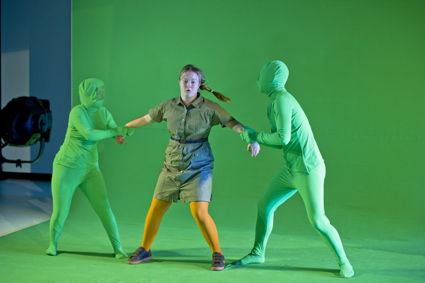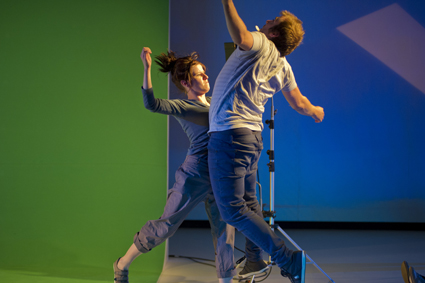transported: between memory & desire
jonathan bollen: restless dance theatre, take me there, come out

Katherine Evans (centre), Jianna Georgiou and Ciaran Woods, Take Me There
photo Chris Herzfeld
Katherine Evans (centre), Jianna Georgiou and Ciaran Woods, Take Me There
I AM NOT YOUNG ENOUGH TO HAVE GROWN UP WITH MY MEMORIES PLAYING BACK ON HOME VIDEO. WHILE OTHER FAMILIES IN THE SUBURBAN 1970s HAD SUPER 8, MY FAMILY HAD SLIDE SHOWS ON A BED SHEET AND PHOTOGRAPHS STUCK IN ALBUMS. MY MEMORIES OF OTHER TIMES AND PLACES ARE ORDERED, THEREFORE, BY THE SHOOT-AND-SNAP OF PHOTOGRAPHY, NOT BY THE ZOOM-AND-FLOW OF HANDHELD VIDEO. I SEE THE IMAGE BUT I DON’T REMEMBER. OR IF I DO, THEN I CAN ONLY RECALL THE FREEZE-FRAME OF THE SINGLE SHOT.
In Take Me There from Restless Dance, performer Alice Kearvell recounts her birthday memories. She begins remarkably with birthday number one: “lots of cuddles with my family and had a BBQ and dessert and I got shy.” By her second: “I was screaming and my brother put his hands over his ears. And I remember my sister was there and we had party food and dessert.” And for her third: “I think we went out for tea, no lunch, that’s right, at the cafe. And I remember had party food and dessert.”
Alice mediates these memories on stage from a green expanse of chroma-key, while live video of her performing is composited with home videos of her birthday celebrations. The resulting memory-flow is streamed to seven screens strapped-up around the stage. Other performers enter singing “Happy Birthday” and carrying gas-filled party balloons. But this is not a re-enactment. It is more a tribute to the displacements of home video, flowing into memory formations of the self elsewhere—at other times, in other places.
Beside the green expanse and video screens, the 12 performers in this work occupy a space—designed by Gaelle Mellis—which is as empty as a waiting room with its row of plastic chairs and a single potted plant. Where else do they want to go?
Dana hangs out with some friends in an abandoned house. Matt wants to be anywhere, stretched out and relaxed, lying on the grass. But Jennie can’t get anywhere, wherever that may be. Kathryn wants to go downtown to the rough-and-tumble of the inner city. Lorcan wants to go to Ireland. Courts goes swimming in the pool and Dana remembers snow falling in Romania.
The video magic of chroma-key makes these escapes of memory and imagination possible on stage and screens—or so it seems. When Lorcan flies to Ireland, he takes his seat in the aeroplane as the ensemble joins him from the side. Together they dance the gestures of the flight attendants’ safety routine. Once in Ireland, Lorcan—Leprechaun-like—makes another performer disappear from the screen by draping her in green.
When Kathryn goes downtown, she is moved and bumped around by two performers dressed in green. Against a backdrop of city lights and traffic, she jumps and twists and screams unheard. On the screens, of course, her manipulators have disappeared; she is tossed and turned by the unseen forces of the city.

Courts White and Jesse Rochow, Take Me There
photo Chris Herzfeld
Courts White and Jesse Rochow, Take Me There
The work itself bears the traces of its making. Director Daniel Koerner asks the audience in the program—as he may have asked the performers in rehearsal—“If you had the chance to go anywhere, do anything, where would you go? What would you do there?” Technological conceits of appearance and actuality are exposed in the performance with humour, tracing the cruelty of those liberal injunctions to “be who you want to be” and “go where you want to go.”
Aspirations to overcome the constraints of time, place and physical capacity are mediated by memories and technologies. But the gap between individual aspirations and the uniformity of ensemble behaviour is not so thoroughly explored. Individual imperatives to “take me there” are met with collective actions in response that set limits and refusals. The performance only tolerates one aspirant at a time, who must return to the ensemble if they are to grant freedom to another.
There is even something slightly petulant about the work’s imperative. “Take me there” sounds like an unruly child speaking to a reluctant parent, or a traveller of privilege issuing instruction to a driver—as if the speaker is incapable of getting there without the generosity of our contribution.
Between the individual and the ensemble there is also scope for mid-scale interactions less explored in this work. In choreographies of twos and threes and fours, performers say to us and others, not “take me there,” but “we’re getting out of here!”
Come Out Festival, Restless Dance Theatre, Take Me There, director Daniel Koerner, assistant director Philip Channells, designer Gaelle Mellis, lighting designer David Gadsen, composer Ian Moorhead, Adelaide Festival Centre, March 25-April 2; www.restlessdance.org
This article was first published as part of the May 10 e-dition.
See also RealTime’s Archive Highlight on Arts & Disability, with an introduction by Anna Hickey-Moody
RealTime issue #103 June-July 2011 pg. 38






